Social Engagement for Schizophrenia
VerifiedAdded on 2022/11/16
|16
|4389
|247
AI Summary
This report discusses the importance of social engagement for individuals with schizophrenia, particularly in the inner city setting of the UK. It also explores the use of Dialectical Behavior Therapy (DBT) as an intervention to prevent social isolation and promote coping mechanisms. The MOHO model of occupational therapy is also discussed as a potential tool for assessing improvement in patients. The report highlights the need for improved services for older adults with schizophrenia and the growing trend of ageism in mental health care.
Contribute Materials
Your contribution can guide someone’s learning journey. Share your
documents today.
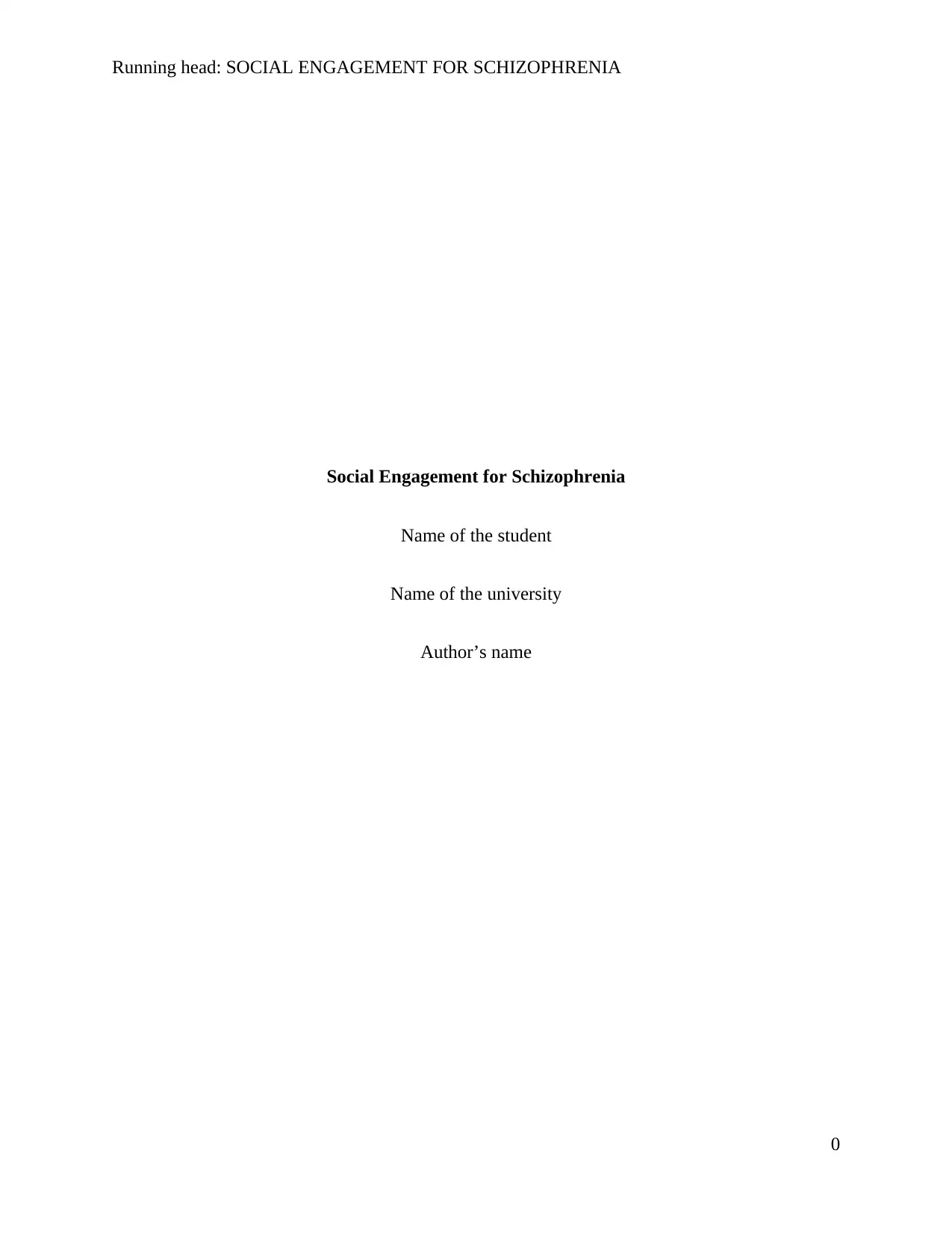
Running head: SOCIAL ENGAGEMENT FOR SCHIZOPHRENIA
Social Engagement for Schizophrenia
Name of the student
Name of the university
Author’s name
0
Social Engagement for Schizophrenia
Name of the student
Name of the university
Author’s name
0
Secure Best Marks with AI Grader
Need help grading? Try our AI Grader for instant feedback on your assignments.
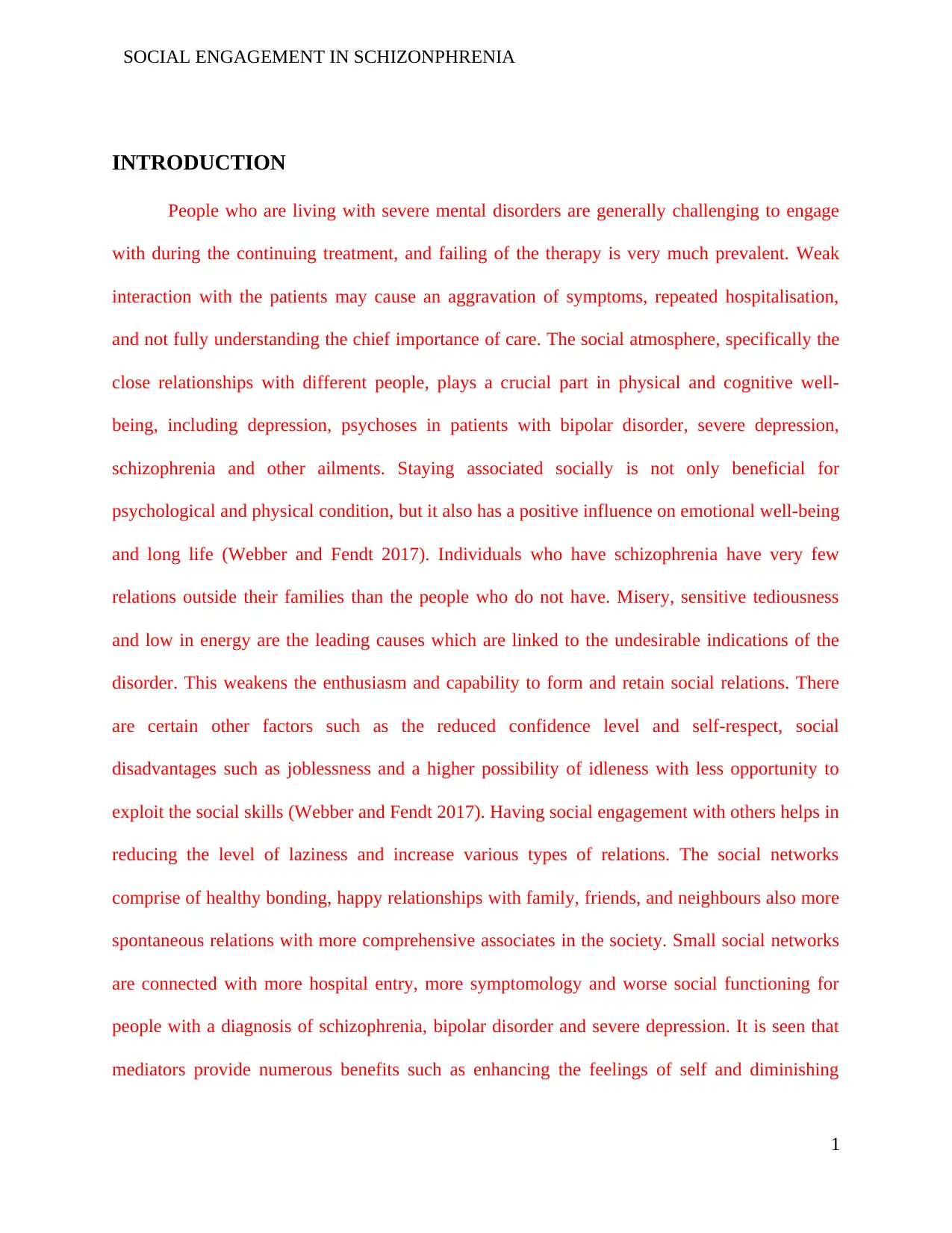
SOCIAL ENGAGEMENT IN SCHIZONPHRENIA
INTRODUCTION
People who are living with severe mental disorders are generally challenging to engage
with during the continuing treatment, and failing of the therapy is very much prevalent. Weak
interaction with the patients may cause an aggravation of symptoms, repeated hospitalisation,
and not fully understanding the chief importance of care. The social atmosphere, specifically the
close relationships with different people, plays a crucial part in physical and cognitive well-
being, including depression, psychoses in patients with bipolar disorder, severe depression,
schizophrenia and other ailments. Staying associated socially is not only beneficial for
psychological and physical condition, but it also has a positive influence on emotional well-being
and long life (Webber and Fendt 2017). Individuals who have schizophrenia have very few
relations outside their families than the people who do not have. Misery, sensitive tediousness
and low in energy are the leading causes which are linked to the undesirable indications of the
disorder. This weakens the enthusiasm and capability to form and retain social relations. There
are certain other factors such as the reduced confidence level and self-respect, social
disadvantages such as joblessness and a higher possibility of idleness with less opportunity to
exploit the social skills (Webber and Fendt 2017). Having social engagement with others helps in
reducing the level of laziness and increase various types of relations. The social networks
comprise of healthy bonding, happy relationships with family, friends, and neighbours also more
spontaneous relations with more comprehensive associates in the society. Small social networks
are connected with more hospital entry, more symptomology and worse social functioning for
people with a diagnosis of schizophrenia, bipolar disorder and severe depression. It is seen that
mediators provide numerous benefits such as enhancing the feelings of self and diminishing
1
INTRODUCTION
People who are living with severe mental disorders are generally challenging to engage
with during the continuing treatment, and failing of the therapy is very much prevalent. Weak
interaction with the patients may cause an aggravation of symptoms, repeated hospitalisation,
and not fully understanding the chief importance of care. The social atmosphere, specifically the
close relationships with different people, plays a crucial part in physical and cognitive well-
being, including depression, psychoses in patients with bipolar disorder, severe depression,
schizophrenia and other ailments. Staying associated socially is not only beneficial for
psychological and physical condition, but it also has a positive influence on emotional well-being
and long life (Webber and Fendt 2017). Individuals who have schizophrenia have very few
relations outside their families than the people who do not have. Misery, sensitive tediousness
and low in energy are the leading causes which are linked to the undesirable indications of the
disorder. This weakens the enthusiasm and capability to form and retain social relations. There
are certain other factors such as the reduced confidence level and self-respect, social
disadvantages such as joblessness and a higher possibility of idleness with less opportunity to
exploit the social skills (Webber and Fendt 2017). Having social engagement with others helps in
reducing the level of laziness and increase various types of relations. The social networks
comprise of healthy bonding, happy relationships with family, friends, and neighbours also more
spontaneous relations with more comprehensive associates in the society. Small social networks
are connected with more hospital entry, more symptomology and worse social functioning for
people with a diagnosis of schizophrenia, bipolar disorder and severe depression. It is seen that
mediators provide numerous benefits such as enhancing the feelings of self and diminishing
1
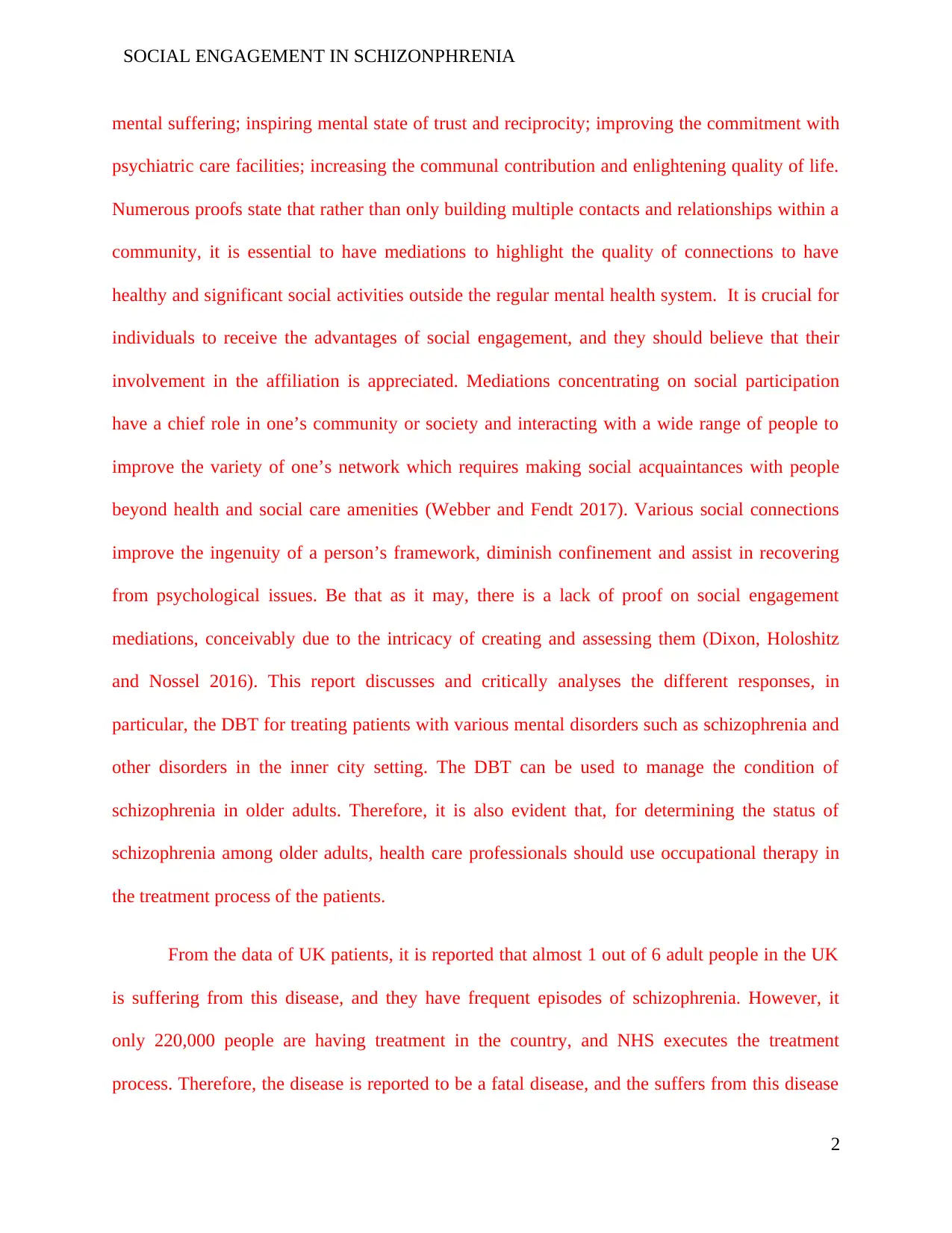
SOCIAL ENGAGEMENT IN SCHIZONPHRENIA
mental suffering; inspiring mental state of trust and reciprocity; improving the commitment with
psychiatric care facilities; increasing the communal contribution and enlightening quality of life.
Numerous proofs state that rather than only building multiple contacts and relationships within a
community, it is essential to have mediations to highlight the quality of connections to have
healthy and significant social activities outside the regular mental health system. It is crucial for
individuals to receive the advantages of social engagement, and they should believe that their
involvement in the affiliation is appreciated. Mediations concentrating on social participation
have a chief role in one’s community or society and interacting with a wide range of people to
improve the variety of one’s network which requires making social acquaintances with people
beyond health and social care amenities (Webber and Fendt 2017). Various social connections
improve the ingenuity of a person’s framework, diminish confinement and assist in recovering
from psychological issues. Be that as it may, there is a lack of proof on social engagement
mediations, conceivably due to the intricacy of creating and assessing them (Dixon, Holoshitz
and Nossel 2016). This report discusses and critically analyses the different responses, in
particular, the DBT for treating patients with various mental disorders such as schizophrenia and
other disorders in the inner city setting. The DBT can be used to manage the condition of
schizophrenia in older adults. Therefore, it is also evident that, for determining the status of
schizophrenia among older adults, health care professionals should use occupational therapy in
the treatment process of the patients.
From the data of UK patients, it is reported that almost 1 out of 6 adult people in the UK
is suffering from this disease, and they have frequent episodes of schizophrenia. However, it
only 220,000 people are having treatment in the country, and NHS executes the treatment
process. Therefore, the disease is reported to be a fatal disease, and the suffers from this disease
2
mental suffering; inspiring mental state of trust and reciprocity; improving the commitment with
psychiatric care facilities; increasing the communal contribution and enlightening quality of life.
Numerous proofs state that rather than only building multiple contacts and relationships within a
community, it is essential to have mediations to highlight the quality of connections to have
healthy and significant social activities outside the regular mental health system. It is crucial for
individuals to receive the advantages of social engagement, and they should believe that their
involvement in the affiliation is appreciated. Mediations concentrating on social participation
have a chief role in one’s community or society and interacting with a wide range of people to
improve the variety of one’s network which requires making social acquaintances with people
beyond health and social care amenities (Webber and Fendt 2017). Various social connections
improve the ingenuity of a person’s framework, diminish confinement and assist in recovering
from psychological issues. Be that as it may, there is a lack of proof on social engagement
mediations, conceivably due to the intricacy of creating and assessing them (Dixon, Holoshitz
and Nossel 2016). This report discusses and critically analyses the different responses, in
particular, the DBT for treating patients with various mental disorders such as schizophrenia and
other disorders in the inner city setting. The DBT can be used to manage the condition of
schizophrenia in older adults. Therefore, it is also evident that, for determining the status of
schizophrenia among older adults, health care professionals should use occupational therapy in
the treatment process of the patients.
From the data of UK patients, it is reported that almost 1 out of 6 adult people in the UK
is suffering from this disease, and they have frequent episodes of schizophrenia. However, it
only 220,000 people are having treatment in the country, and NHS executes the treatment
process. Therefore, the disease is reported to be a fatal disease, and the suffers from this disease
2

SOCIAL ENGAGEMENT IN SCHIZONPHRENIA
have 5-10 per cent chances of facing mortality due to this disease as well. As schizophrenia is a
critical mental illness, it is also associated with the various other adverse effects on the human
body. The Occupational Therapy (OT) generally uses multiple theoretical approaches for
determining the conditions of the patients.
THE CLIENT GROUP
In this report, the condition of the adults with schizophrenia in the UK will be analysed in
a brief manner. Schizophrenia is mostly under rated in most of the countries in this world and
the condition is not at all different in case of UK. For the adults the condition of the mental
health states is very poor due to the age discrimination and poor physical health condition as
well. Apart from that, there is a growing trends of enhancing the aging population of the country
as well. Therefore, ageism has become a serious problem for the National Health Services (NHS)
and they are liable to provide good services and facilities to the older adults patients with
schizophrenia in UK. In case of mental health professionals and mental health care providers, it
is reported that, there are high chances of biases in the services to the older adults. Hence, it is
recommended that the services delivered to them must be improved in order to deliver a good
services to them. According to the data of the ONS (2016), it is reported that, in next few years
the number of aging p9pulation in the UK will be enhanced a lot and this will make the
condition worse in terms of getting treatment for the schizophrenia and related mental health
disorder as well. By assuming the data of the UK population, it is reported that there will be
almost 13% increase in the aging population in the UK population buy the end of 2046 and to be
more precise, the surge will be 12. 7% in the aging population in the UK. The number of
population within the age group of 65 or more will be enhanced almost 55.1 % and in case of the
3
have 5-10 per cent chances of facing mortality due to this disease as well. As schizophrenia is a
critical mental illness, it is also associated with the various other adverse effects on the human
body. The Occupational Therapy (OT) generally uses multiple theoretical approaches for
determining the conditions of the patients.
THE CLIENT GROUP
In this report, the condition of the adults with schizophrenia in the UK will be analysed in
a brief manner. Schizophrenia is mostly under rated in most of the countries in this world and
the condition is not at all different in case of UK. For the adults the condition of the mental
health states is very poor due to the age discrimination and poor physical health condition as
well. Apart from that, there is a growing trends of enhancing the aging population of the country
as well. Therefore, ageism has become a serious problem for the National Health Services (NHS)
and they are liable to provide good services and facilities to the older adults patients with
schizophrenia in UK. In case of mental health professionals and mental health care providers, it
is reported that, there are high chances of biases in the services to the older adults. Hence, it is
recommended that the services delivered to them must be improved in order to deliver a good
services to them. According to the data of the ONS (2016), it is reported that, in next few years
the number of aging p9pulation in the UK will be enhanced a lot and this will make the
condition worse in terms of getting treatment for the schizophrenia and related mental health
disorder as well. By assuming the data of the UK population, it is reported that there will be
almost 13% increase in the aging population in the UK population buy the end of 2046 and to be
more precise, the surge will be 12. 7% in the aging population in the UK. The number of
population within the age group of 65 or more will be enhanced almost 55.1 % and in case of the
3
Secure Best Marks with AI Grader
Need help grading? Try our AI Grader for instant feedback on your assignments.
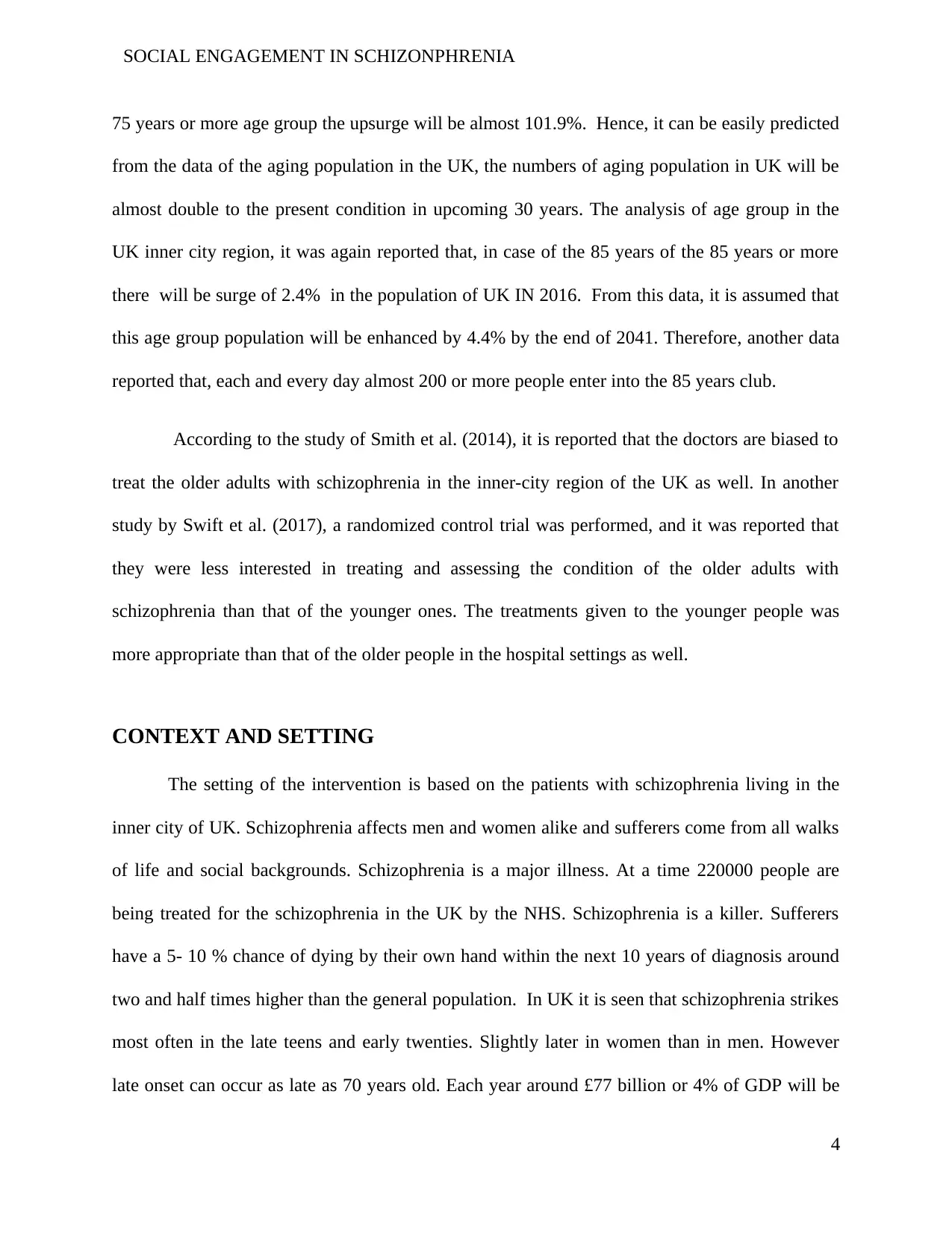
SOCIAL ENGAGEMENT IN SCHIZONPHRENIA
75 years or more age group the upsurge will be almost 101.9%. Hence, it can be easily predicted
from the data of the aging population in the UK, the numbers of aging population in UK will be
almost double to the present condition in upcoming 30 years. The analysis of age group in the
UK inner city region, it was again reported that, in case of the 85 years of the 85 years or more
there will be surge of 2.4% in the population of UK IN 2016. From this data, it is assumed that
this age group population will be enhanced by 4.4% by the end of 2041. Therefore, another data
reported that, each and every day almost 200 or more people enter into the 85 years club.
According to the study of Smith et al. (2014), it is reported that the doctors are biased to
treat the older adults with schizophrenia in the inner-city region of the UK as well. In another
study by Swift et al. (2017), a randomized control trial was performed, and it was reported that
they were less interested in treating and assessing the condition of the older adults with
schizophrenia than that of the younger ones. The treatments given to the younger people was
more appropriate than that of the older people in the hospital settings as well.
CONTEXT AND SETTING
The setting of the intervention is based on the patients with schizophrenia living in the
inner city of UK. Schizophrenia affects men and women alike and sufferers come from all walks
of life and social backgrounds. Schizophrenia is a major illness. At a time 220000 people are
being treated for the schizophrenia in the UK by the NHS. Schizophrenia is a killer. Sufferers
have a 5- 10 % chance of dying by their own hand within the next 10 years of diagnosis around
two and half times higher than the general population. In UK it is seen that schizophrenia strikes
most often in the late teens and early twenties. Slightly later in women than in men. However
late onset can occur as late as 70 years old. Each year around £77 billion or 4% of GDP will be
4
75 years or more age group the upsurge will be almost 101.9%. Hence, it can be easily predicted
from the data of the aging population in the UK, the numbers of aging population in UK will be
almost double to the present condition in upcoming 30 years. The analysis of age group in the
UK inner city region, it was again reported that, in case of the 85 years of the 85 years or more
there will be surge of 2.4% in the population of UK IN 2016. From this data, it is assumed that
this age group population will be enhanced by 4.4% by the end of 2041. Therefore, another data
reported that, each and every day almost 200 or more people enter into the 85 years club.
According to the study of Smith et al. (2014), it is reported that the doctors are biased to
treat the older adults with schizophrenia in the inner-city region of the UK as well. In another
study by Swift et al. (2017), a randomized control trial was performed, and it was reported that
they were less interested in treating and assessing the condition of the older adults with
schizophrenia than that of the younger ones. The treatments given to the younger people was
more appropriate than that of the older people in the hospital settings as well.
CONTEXT AND SETTING
The setting of the intervention is based on the patients with schizophrenia living in the
inner city of UK. Schizophrenia affects men and women alike and sufferers come from all walks
of life and social backgrounds. Schizophrenia is a major illness. At a time 220000 people are
being treated for the schizophrenia in the UK by the NHS. Schizophrenia is a killer. Sufferers
have a 5- 10 % chance of dying by their own hand within the next 10 years of diagnosis around
two and half times higher than the general population. In UK it is seen that schizophrenia strikes
most often in the late teens and early twenties. Slightly later in women than in men. However
late onset can occur as late as 70 years old. Each year around £77 billion or 4% of GDP will be
4
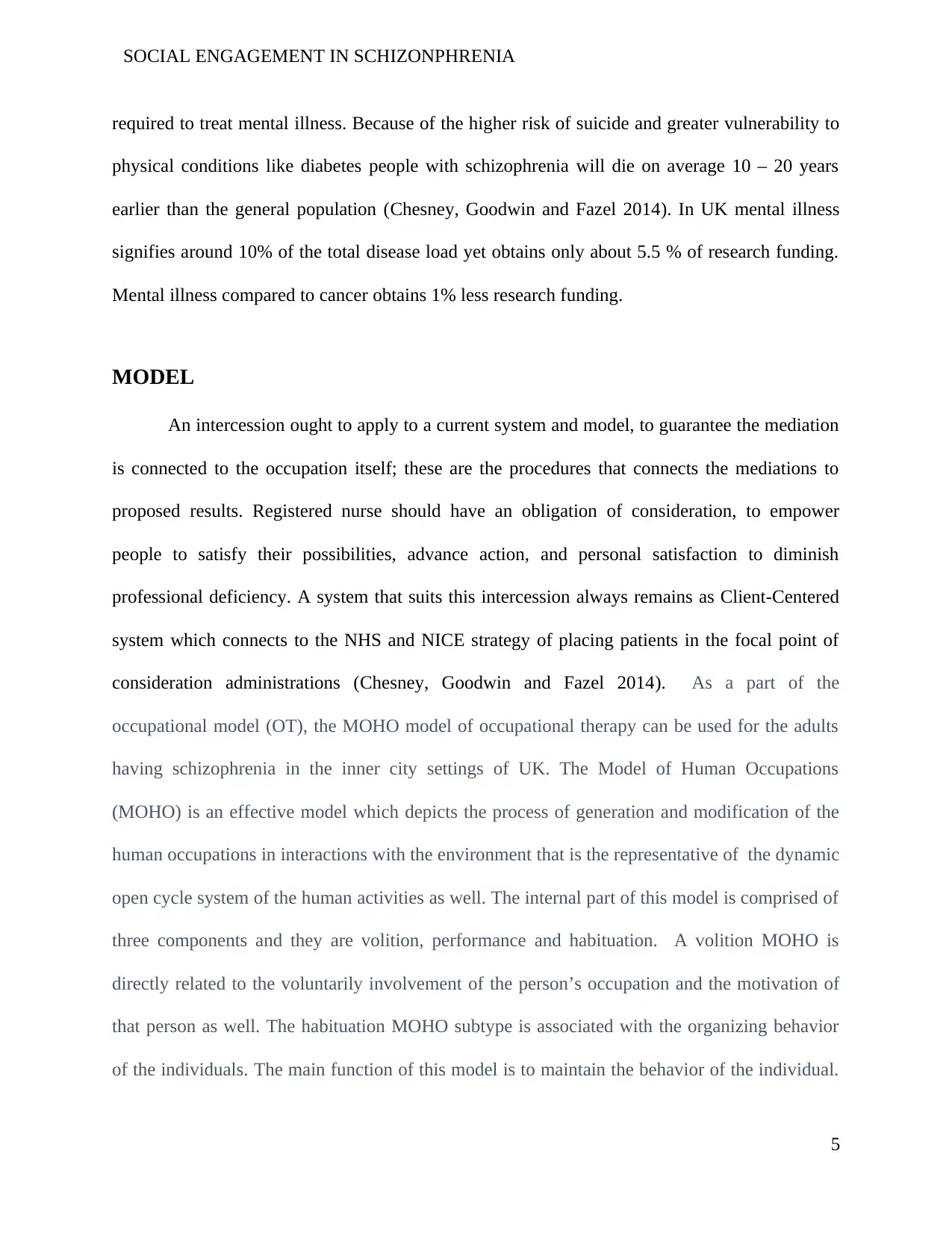
SOCIAL ENGAGEMENT IN SCHIZONPHRENIA
required to treat mental illness. Because of the higher risk of suicide and greater vulnerability to
physical conditions like diabetes people with schizophrenia will die on average 10 – 20 years
earlier than the general population (Chesney, Goodwin and Fazel 2014). In UK mental illness
signifies around 10% of the total disease load yet obtains only about 5.5 % of research funding.
Mental illness compared to cancer obtains 1% less research funding.
MODEL
An intercession ought to apply to a current system and model, to guarantee the mediation
is connected to the occupation itself; these are the procedures that connects the mediations to
proposed results. Registered nurse should have an obligation of consideration, to empower
people to satisfy their possibilities, advance action, and personal satisfaction to diminish
professional deficiency. A system that suits this intercession always remains as Client-Centered
system which connects to the NHS and NICE strategy of placing patients in the focal point of
consideration administrations (Chesney, Goodwin and Fazel 2014). As a part of the
occupational model (OT), the MOHO model of occupational therapy can be used for the adults
having schizophrenia in the inner city settings of UK. The Model of Human Occupations
(MOHO) is an effective model which depicts the process of generation and modification of the
human occupations in interactions with the environment that is the representative of the dynamic
open cycle system of the human activities as well. The internal part of this model is comprised of
three components and they are volition, performance and habituation. A volition MOHO is
directly related to the voluntarily involvement of the person’s occupation and the motivation of
that person as well. The habituation MOHO subtype is associated with the organizing behavior
of the individuals. The main function of this model is to maintain the behavior of the individual.
5
required to treat mental illness. Because of the higher risk of suicide and greater vulnerability to
physical conditions like diabetes people with schizophrenia will die on average 10 – 20 years
earlier than the general population (Chesney, Goodwin and Fazel 2014). In UK mental illness
signifies around 10% of the total disease load yet obtains only about 5.5 % of research funding.
Mental illness compared to cancer obtains 1% less research funding.
MODEL
An intercession ought to apply to a current system and model, to guarantee the mediation
is connected to the occupation itself; these are the procedures that connects the mediations to
proposed results. Registered nurse should have an obligation of consideration, to empower
people to satisfy their possibilities, advance action, and personal satisfaction to diminish
professional deficiency. A system that suits this intercession always remains as Client-Centered
system which connects to the NHS and NICE strategy of placing patients in the focal point of
consideration administrations (Chesney, Goodwin and Fazel 2014). As a part of the
occupational model (OT), the MOHO model of occupational therapy can be used for the adults
having schizophrenia in the inner city settings of UK. The Model of Human Occupations
(MOHO) is an effective model which depicts the process of generation and modification of the
human occupations in interactions with the environment that is the representative of the dynamic
open cycle system of the human activities as well. The internal part of this model is comprised of
three components and they are volition, performance and habituation. A volition MOHO is
directly related to the voluntarily involvement of the person’s occupation and the motivation of
that person as well. The habituation MOHO subtype is associated with the organizing behavior
of the individuals. The main function of this model is to maintain the behavior of the individual.
5
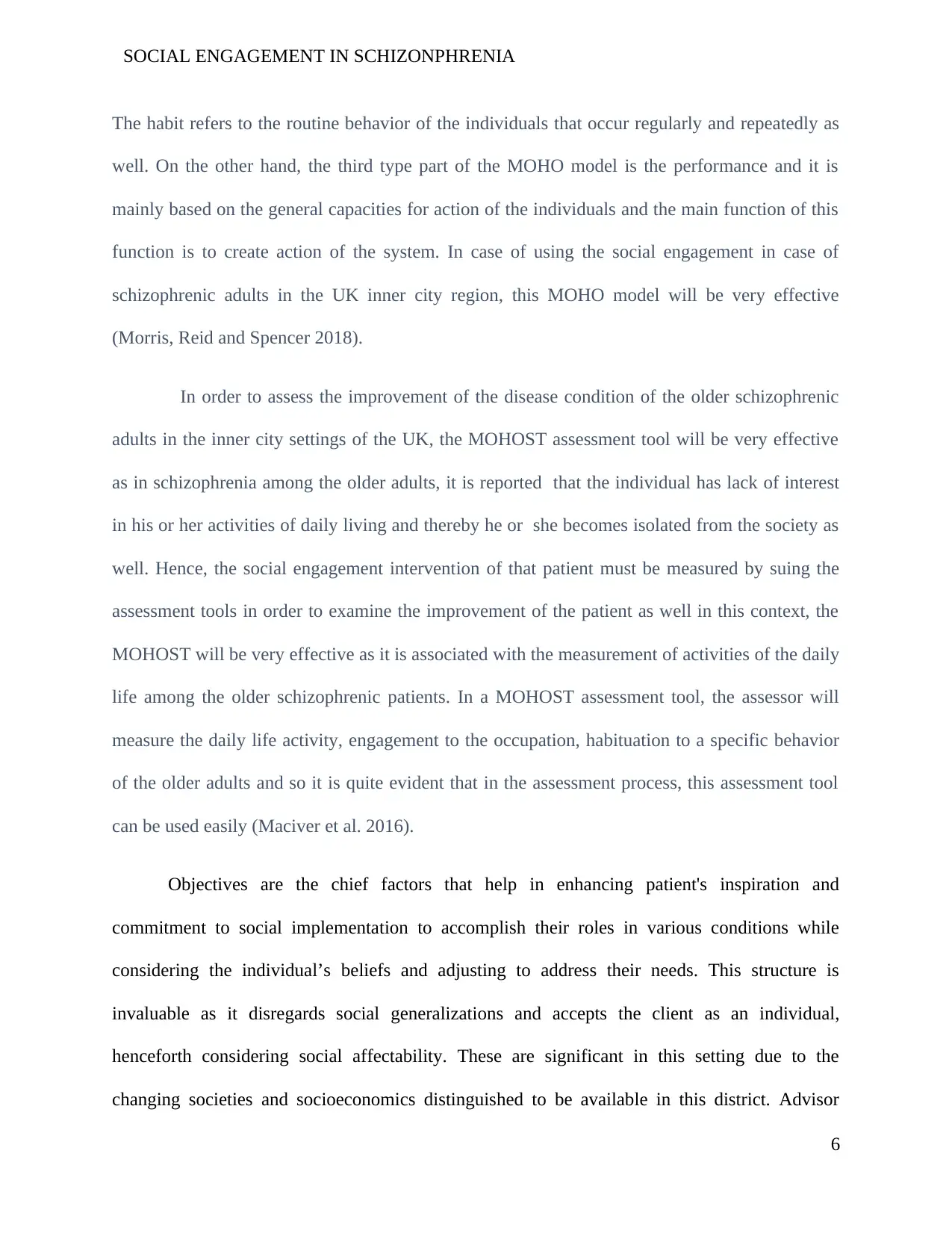
SOCIAL ENGAGEMENT IN SCHIZONPHRENIA
The habit refers to the routine behavior of the individuals that occur regularly and repeatedly as
well. On the other hand, the third type part of the MOHO model is the performance and it is
mainly based on the general capacities for action of the individuals and the main function of this
function is to create action of the system. In case of using the social engagement in case of
schizophrenic adults in the UK inner city region, this MOHO model will be very effective
(Morris, Reid and Spencer 2018).
In order to assess the improvement of the disease condition of the older schizophrenic
adults in the inner city settings of the UK, the MOHOST assessment tool will be very effective
as in schizophrenia among the older adults, it is reported that the individual has lack of interest
in his or her activities of daily living and thereby he or she becomes isolated from the society as
well. Hence, the social engagement intervention of that patient must be measured by suing the
assessment tools in order to examine the improvement of the patient as well in this context, the
MOHOST will be very effective as it is associated with the measurement of activities of the daily
life among the older schizophrenic patients. In a MOHOST assessment tool, the assessor will
measure the daily life activity, engagement to the occupation, habituation to a specific behavior
of the older adults and so it is quite evident that in the assessment process, this assessment tool
can be used easily (Maciver et al. 2016).
Objectives are the chief factors that help in enhancing patient's inspiration and
commitment to social implementation to accomplish their roles in various conditions while
considering the individual’s beliefs and adjusting to address their needs. This structure is
invaluable as it disregards social generalizations and accepts the client as an individual,
henceforth considering social affectability. These are significant in this setting due to the
changing societies and socioeconomics distinguished to be available in this district. Advisor
6
The habit refers to the routine behavior of the individuals that occur regularly and repeatedly as
well. On the other hand, the third type part of the MOHO model is the performance and it is
mainly based on the general capacities for action of the individuals and the main function of this
function is to create action of the system. In case of using the social engagement in case of
schizophrenic adults in the UK inner city region, this MOHO model will be very effective
(Morris, Reid and Spencer 2018).
In order to assess the improvement of the disease condition of the older schizophrenic
adults in the inner city settings of the UK, the MOHOST assessment tool will be very effective
as in schizophrenia among the older adults, it is reported that the individual has lack of interest
in his or her activities of daily living and thereby he or she becomes isolated from the society as
well. Hence, the social engagement intervention of that patient must be measured by suing the
assessment tools in order to examine the improvement of the patient as well in this context, the
MOHOST will be very effective as it is associated with the measurement of activities of the daily
life among the older schizophrenic patients. In a MOHOST assessment tool, the assessor will
measure the daily life activity, engagement to the occupation, habituation to a specific behavior
of the older adults and so it is quite evident that in the assessment process, this assessment tool
can be used easily (Maciver et al. 2016).
Objectives are the chief factors that help in enhancing patient's inspiration and
commitment to social implementation to accomplish their roles in various conditions while
considering the individual’s beliefs and adjusting to address their needs. This structure is
invaluable as it disregards social generalizations and accepts the client as an individual,
henceforth considering social affectability. These are significant in this setting due to the
changing societies and socioeconomics distinguished to be available in this district. Advisor
6
Paraphrase This Document
Need a fresh take? Get an instant paraphrase of this document with our AI Paraphraser
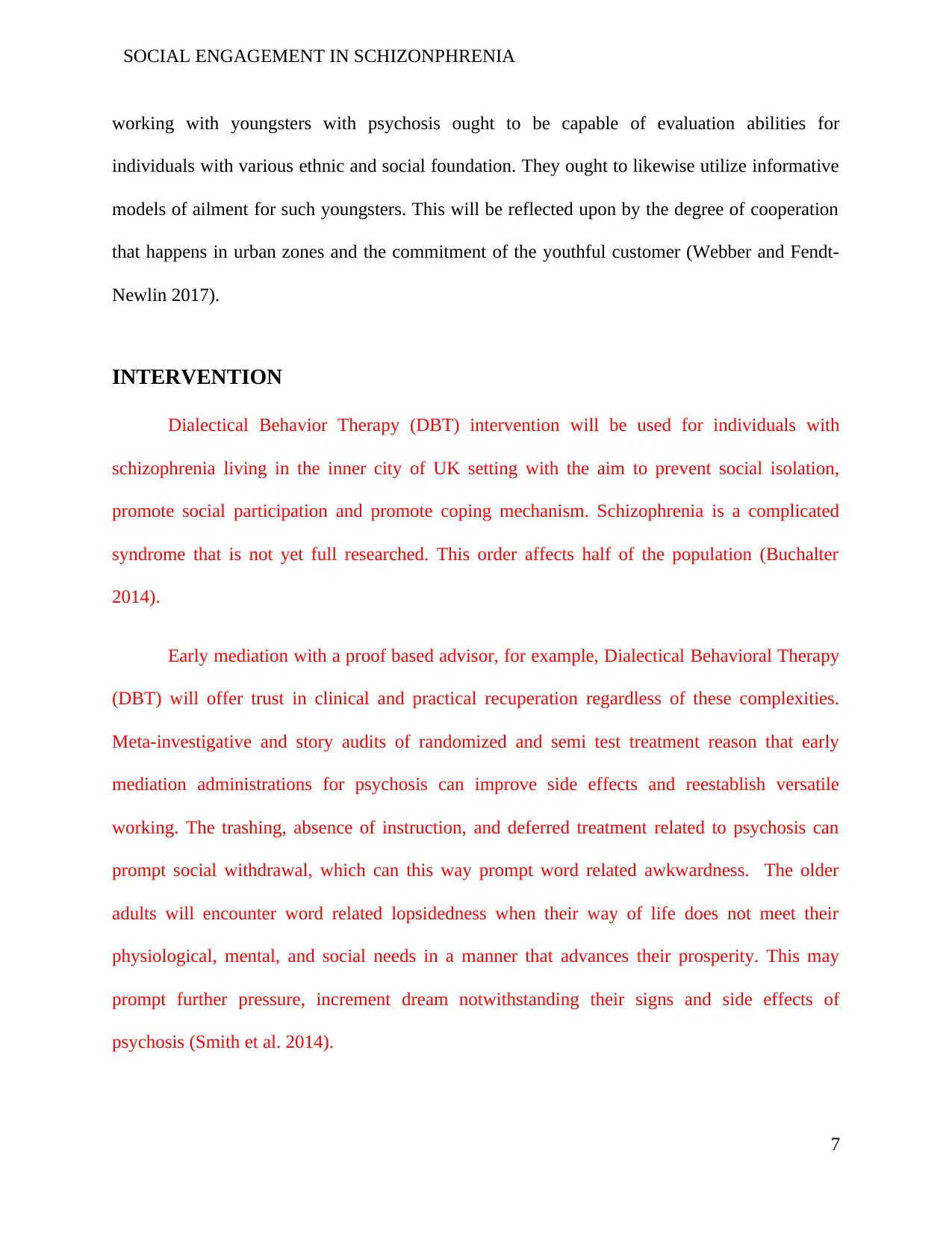
SOCIAL ENGAGEMENT IN SCHIZONPHRENIA
working with youngsters with psychosis ought to be capable of evaluation abilities for
individuals with various ethnic and social foundation. They ought to likewise utilize informative
models of ailment for such youngsters. This will be reflected upon by the degree of cooperation
that happens in urban zones and the commitment of the youthful customer (Webber and Fendt-
Newlin 2017).
INTERVENTION
Dialectical Behavior Therapy (DBT) intervention will be used for individuals with
schizophrenia living in the inner city of UK setting with the aim to prevent social isolation,
promote social participation and promote coping mechanism. Schizophrenia is a complicated
syndrome that is not yet full researched. This order affects half of the population (Buchalter
2014).
Early mediation with a proof based advisor, for example, Dialectical Behavioral Therapy
(DBT) will offer trust in clinical and practical recuperation regardless of these complexities.
Meta-investigative and story audits of randomized and semi test treatment reason that early
mediation administrations for psychosis can improve side effects and reestablish versatile
working. The trashing, absence of instruction, and deferred treatment related to psychosis can
prompt social withdrawal, which can this way prompt word related awkwardness. The older
adults will encounter word related lopsidedness when their way of life does not meet their
physiological, mental, and social needs in a manner that advances their prosperity. This may
prompt further pressure, increment dream notwithstanding their signs and side effects of
psychosis (Smith et al. 2014).
7
working with youngsters with psychosis ought to be capable of evaluation abilities for
individuals with various ethnic and social foundation. They ought to likewise utilize informative
models of ailment for such youngsters. This will be reflected upon by the degree of cooperation
that happens in urban zones and the commitment of the youthful customer (Webber and Fendt-
Newlin 2017).
INTERVENTION
Dialectical Behavior Therapy (DBT) intervention will be used for individuals with
schizophrenia living in the inner city of UK setting with the aim to prevent social isolation,
promote social participation and promote coping mechanism. Schizophrenia is a complicated
syndrome that is not yet full researched. This order affects half of the population (Buchalter
2014).
Early mediation with a proof based advisor, for example, Dialectical Behavioral Therapy
(DBT) will offer trust in clinical and practical recuperation regardless of these complexities.
Meta-investigative and story audits of randomized and semi test treatment reason that early
mediation administrations for psychosis can improve side effects and reestablish versatile
working. The trashing, absence of instruction, and deferred treatment related to psychosis can
prompt social withdrawal, which can this way prompt word related awkwardness. The older
adults will encounter word related lopsidedness when their way of life does not meet their
physiological, mental, and social needs in a manner that advances their prosperity. This may
prompt further pressure, increment dream notwithstanding their signs and side effects of
psychosis (Smith et al. 2014).
7
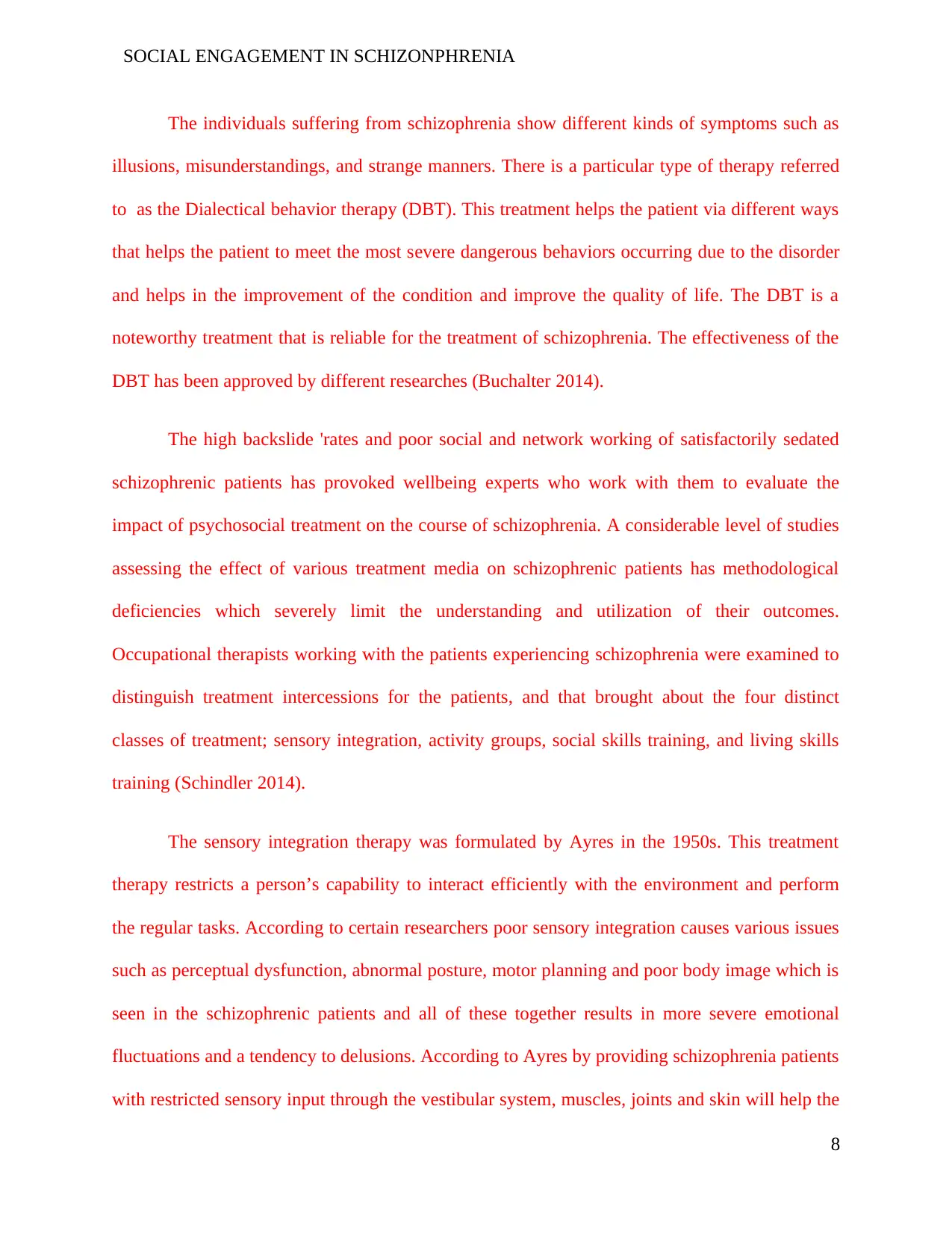
SOCIAL ENGAGEMENT IN SCHIZONPHRENIA
The individuals suffering from schizophrenia show different kinds of symptoms such as
illusions, misunderstandings, and strange manners. There is a particular type of therapy referred
to as the Dialectical behavior therapy (DBT). This treatment helps the patient via different ways
that helps the patient to meet the most severe dangerous behaviors occurring due to the disorder
and helps in the improvement of the condition and improve the quality of life. The DBT is a
noteworthy treatment that is reliable for the treatment of schizophrenia. The effectiveness of the
DBT has been approved by different researches (Buchalter 2014).
The high backslide 'rates and poor social and network working of satisfactorily sedated
schizophrenic patients has provoked wellbeing experts who work with them to evaluate the
impact of psychosocial treatment on the course of schizophrenia. A considerable level of studies
assessing the effect of various treatment media on schizophrenic patients has methodological
deficiencies which severely limit the understanding and utilization of their outcomes.
Occupational therapists working with the patients experiencing schizophrenia were examined to
distinguish treatment intercessions for the patients, and that brought about the four distinct
classes of treatment; sensory integration, activity groups, social skills training, and living skills
training (Schindler 2014).
The sensory integration therapy was formulated by Ayres in the 1950s. This treatment
therapy restricts a person’s capability to interact efficiently with the environment and perform
the regular tasks. According to certain researchers poor sensory integration causes various issues
such as perceptual dysfunction, abnormal posture, motor planning and poor body image which is
seen in the schizophrenic patients and all of these together results in more severe emotional
fluctuations and a tendency to delusions. According to Ayres by providing schizophrenia patients
with restricted sensory input through the vestibular system, muscles, joints and skin will help the
8
The individuals suffering from schizophrenia show different kinds of symptoms such as
illusions, misunderstandings, and strange manners. There is a particular type of therapy referred
to as the Dialectical behavior therapy (DBT). This treatment helps the patient via different ways
that helps the patient to meet the most severe dangerous behaviors occurring due to the disorder
and helps in the improvement of the condition and improve the quality of life. The DBT is a
noteworthy treatment that is reliable for the treatment of schizophrenia. The effectiveness of the
DBT has been approved by different researches (Buchalter 2014).
The high backslide 'rates and poor social and network working of satisfactorily sedated
schizophrenic patients has provoked wellbeing experts who work with them to evaluate the
impact of psychosocial treatment on the course of schizophrenia. A considerable level of studies
assessing the effect of various treatment media on schizophrenic patients has methodological
deficiencies which severely limit the understanding and utilization of their outcomes.
Occupational therapists working with the patients experiencing schizophrenia were examined to
distinguish treatment intercessions for the patients, and that brought about the four distinct
classes of treatment; sensory integration, activity groups, social skills training, and living skills
training (Schindler 2014).
The sensory integration therapy was formulated by Ayres in the 1950s. This treatment
therapy restricts a person’s capability to interact efficiently with the environment and perform
the regular tasks. According to certain researchers poor sensory integration causes various issues
such as perceptual dysfunction, abnormal posture, motor planning and poor body image which is
seen in the schizophrenic patients and all of these together results in more severe emotional
fluctuations and a tendency to delusions. According to Ayres by providing schizophrenia patients
with restricted sensory input through the vestibular system, muscles, joints and skin will help the
8
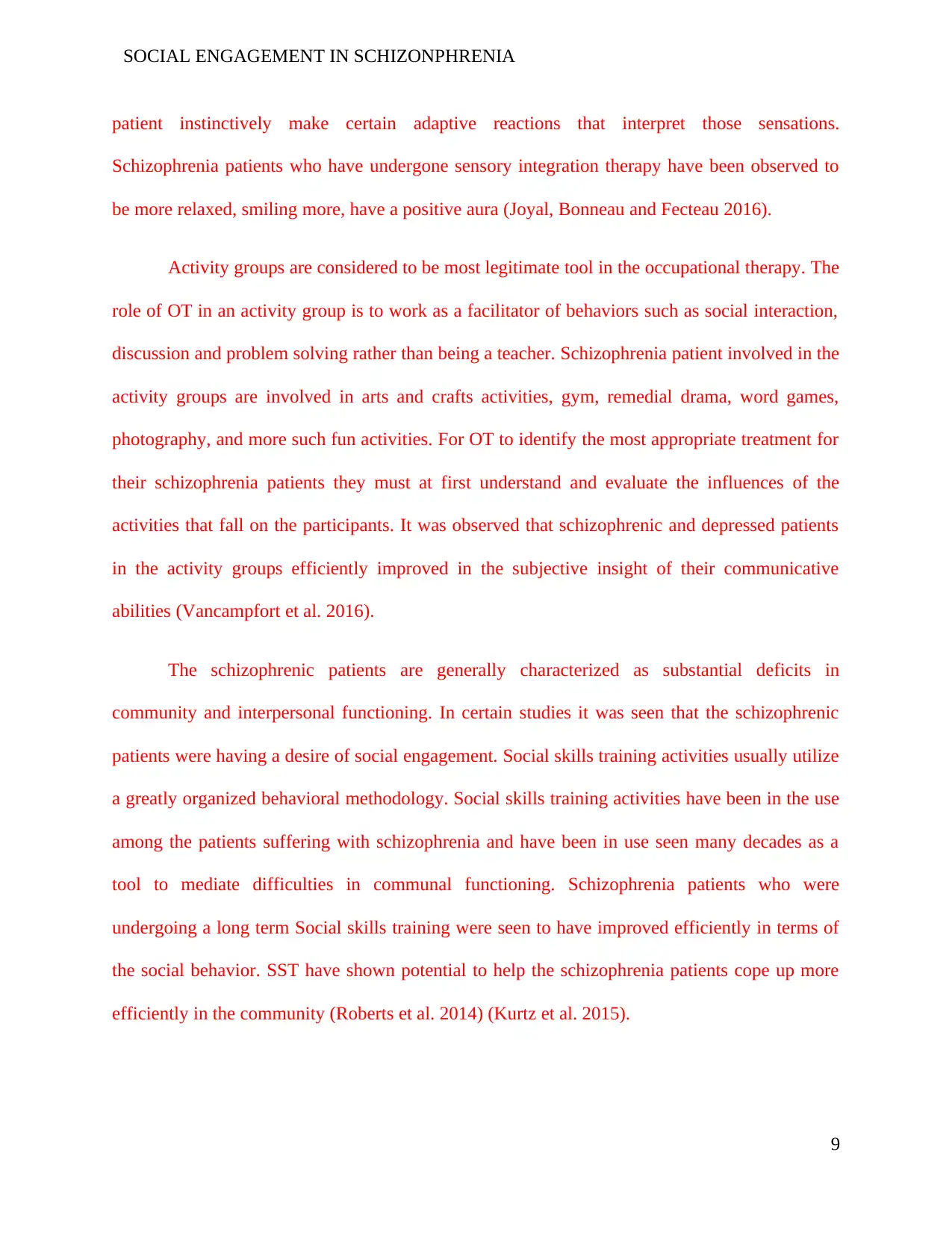
SOCIAL ENGAGEMENT IN SCHIZONPHRENIA
patient instinctively make certain adaptive reactions that interpret those sensations.
Schizophrenia patients who have undergone sensory integration therapy have been observed to
be more relaxed, smiling more, have a positive aura (Joyal, Bonneau and Fecteau 2016).
Activity groups are considered to be most legitimate tool in the occupational therapy. The
role of OT in an activity group is to work as a facilitator of behaviors such as social interaction,
discussion and problem solving rather than being a teacher. Schizophrenia patient involved in the
activity groups are involved in arts and crafts activities, gym, remedial drama, word games,
photography, and more such fun activities. For OT to identify the most appropriate treatment for
their schizophrenia patients they must at first understand and evaluate the influences of the
activities that fall on the participants. It was observed that schizophrenic and depressed patients
in the activity groups efficiently improved in the subjective insight of their communicative
abilities (Vancampfort et al. 2016).
The schizophrenic patients are generally characterized as substantial deficits in
community and interpersonal functioning. In certain studies it was seen that the schizophrenic
patients were having a desire of social engagement. Social skills training activities usually utilize
a greatly organized behavioral methodology. Social skills training activities have been in the use
among the patients suffering with schizophrenia and have been in use seen many decades as a
tool to mediate difficulties in communal functioning. Schizophrenia patients who were
undergoing a long term Social skills training were seen to have improved efficiently in terms of
the social behavior. SST have shown potential to help the schizophrenia patients cope up more
efficiently in the community (Roberts et al. 2014) (Kurtz et al. 2015).
9
patient instinctively make certain adaptive reactions that interpret those sensations.
Schizophrenia patients who have undergone sensory integration therapy have been observed to
be more relaxed, smiling more, have a positive aura (Joyal, Bonneau and Fecteau 2016).
Activity groups are considered to be most legitimate tool in the occupational therapy. The
role of OT in an activity group is to work as a facilitator of behaviors such as social interaction,
discussion and problem solving rather than being a teacher. Schizophrenia patient involved in the
activity groups are involved in arts and crafts activities, gym, remedial drama, word games,
photography, and more such fun activities. For OT to identify the most appropriate treatment for
their schizophrenia patients they must at first understand and evaluate the influences of the
activities that fall on the participants. It was observed that schizophrenic and depressed patients
in the activity groups efficiently improved in the subjective insight of their communicative
abilities (Vancampfort et al. 2016).
The schizophrenic patients are generally characterized as substantial deficits in
community and interpersonal functioning. In certain studies it was seen that the schizophrenic
patients were having a desire of social engagement. Social skills training activities usually utilize
a greatly organized behavioral methodology. Social skills training activities have been in the use
among the patients suffering with schizophrenia and have been in use seen many decades as a
tool to mediate difficulties in communal functioning. Schizophrenia patients who were
undergoing a long term Social skills training were seen to have improved efficiently in terms of
the social behavior. SST have shown potential to help the schizophrenia patients cope up more
efficiently in the community (Roberts et al. 2014) (Kurtz et al. 2015).
9
Secure Best Marks with AI Grader
Need help grading? Try our AI Grader for instant feedback on your assignments.
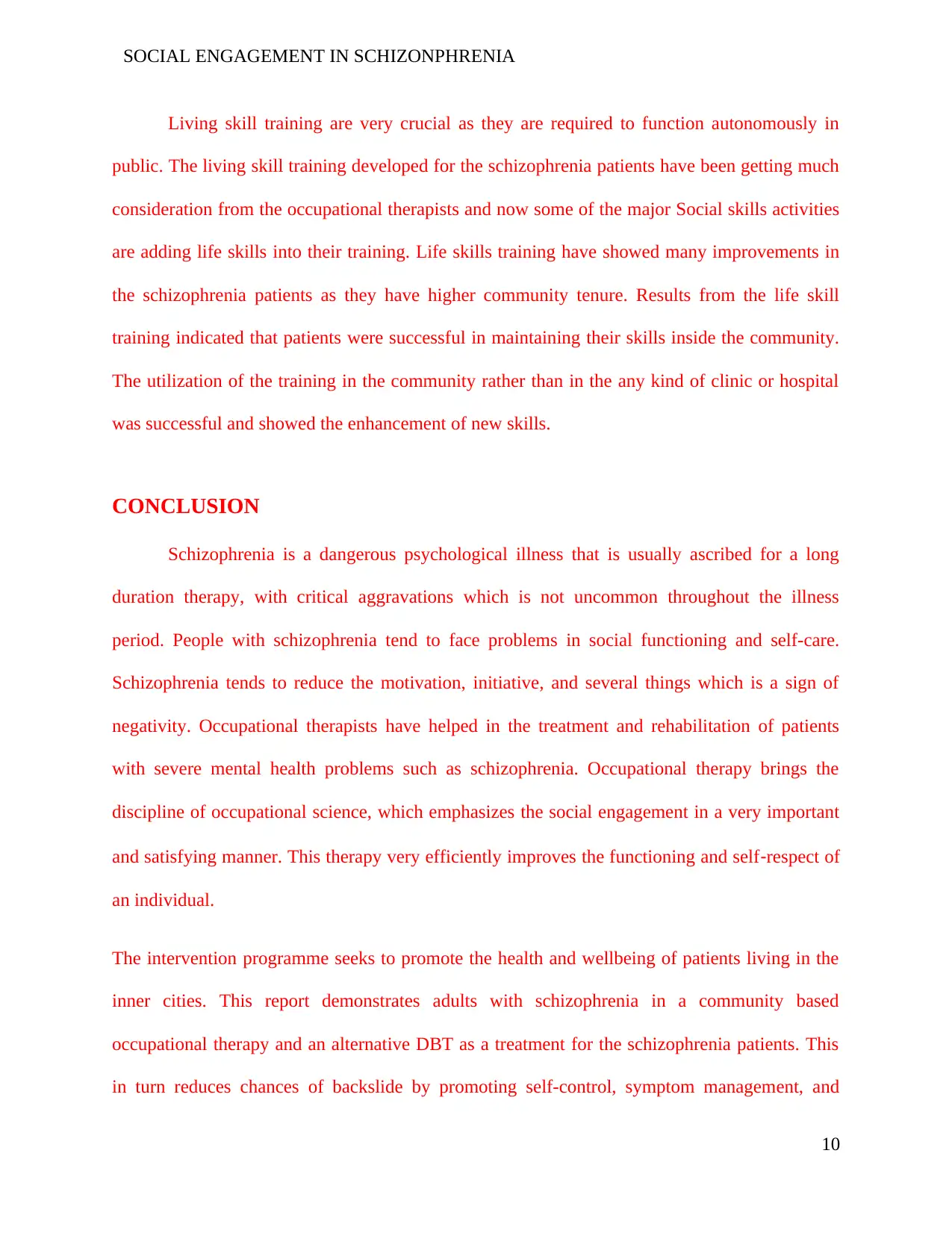
SOCIAL ENGAGEMENT IN SCHIZONPHRENIA
Living skill training are very crucial as they are required to function autonomously in
public. The living skill training developed for the schizophrenia patients have been getting much
consideration from the occupational therapists and now some of the major Social skills activities
are adding life skills into their training. Life skills training have showed many improvements in
the schizophrenia patients as they have higher community tenure. Results from the life skill
training indicated that patients were successful in maintaining their skills inside the community.
The utilization of the training in the community rather than in the any kind of clinic or hospital
was successful and showed the enhancement of new skills.
CONCLUSION
Schizophrenia is a dangerous psychological illness that is usually ascribed for a long
duration therapy, with critical aggravations which is not uncommon throughout the illness
period. People with schizophrenia tend to face problems in social functioning and self-care.
Schizophrenia tends to reduce the motivation, initiative, and several things which is a sign of
negativity. Occupational therapists have helped in the treatment and rehabilitation of patients
with severe mental health problems such as schizophrenia. Occupational therapy brings the
discipline of occupational science, which emphasizes the social engagement in a very important
and satisfying manner. This therapy very efficiently improves the functioning and self‐respect of
an individual.
The intervention programme seeks to promote the health and wellbeing of patients living in the
inner cities. This report demonstrates adults with schizophrenia in a community based
occupational therapy and an alternative DBT as a treatment for the schizophrenia patients. This
in turn reduces chances of backslide by promoting self-control, symptom management, and
10
Living skill training are very crucial as they are required to function autonomously in
public. The living skill training developed for the schizophrenia patients have been getting much
consideration from the occupational therapists and now some of the major Social skills activities
are adding life skills into their training. Life skills training have showed many improvements in
the schizophrenia patients as they have higher community tenure. Results from the life skill
training indicated that patients were successful in maintaining their skills inside the community.
The utilization of the training in the community rather than in the any kind of clinic or hospital
was successful and showed the enhancement of new skills.
CONCLUSION
Schizophrenia is a dangerous psychological illness that is usually ascribed for a long
duration therapy, with critical aggravations which is not uncommon throughout the illness
period. People with schizophrenia tend to face problems in social functioning and self-care.
Schizophrenia tends to reduce the motivation, initiative, and several things which is a sign of
negativity. Occupational therapists have helped in the treatment and rehabilitation of patients
with severe mental health problems such as schizophrenia. Occupational therapy brings the
discipline of occupational science, which emphasizes the social engagement in a very important
and satisfying manner. This therapy very efficiently improves the functioning and self‐respect of
an individual.
The intervention programme seeks to promote the health and wellbeing of patients living in the
inner cities. This report demonstrates adults with schizophrenia in a community based
occupational therapy and an alternative DBT as a treatment for the schizophrenia patients. This
in turn reduces chances of backslide by promoting self-control, symptom management, and
10

SOCIAL ENGAGEMENT IN SCHIZONPHRENIA
social engagement with family, friends, neighbors and other people outside the families. The
programme also addresses the different psychological issues related to organizing regular
activities.
11
social engagement with family, friends, neighbors and other people outside the families. The
programme also addresses the different psychological issues related to organizing regular
activities.
11
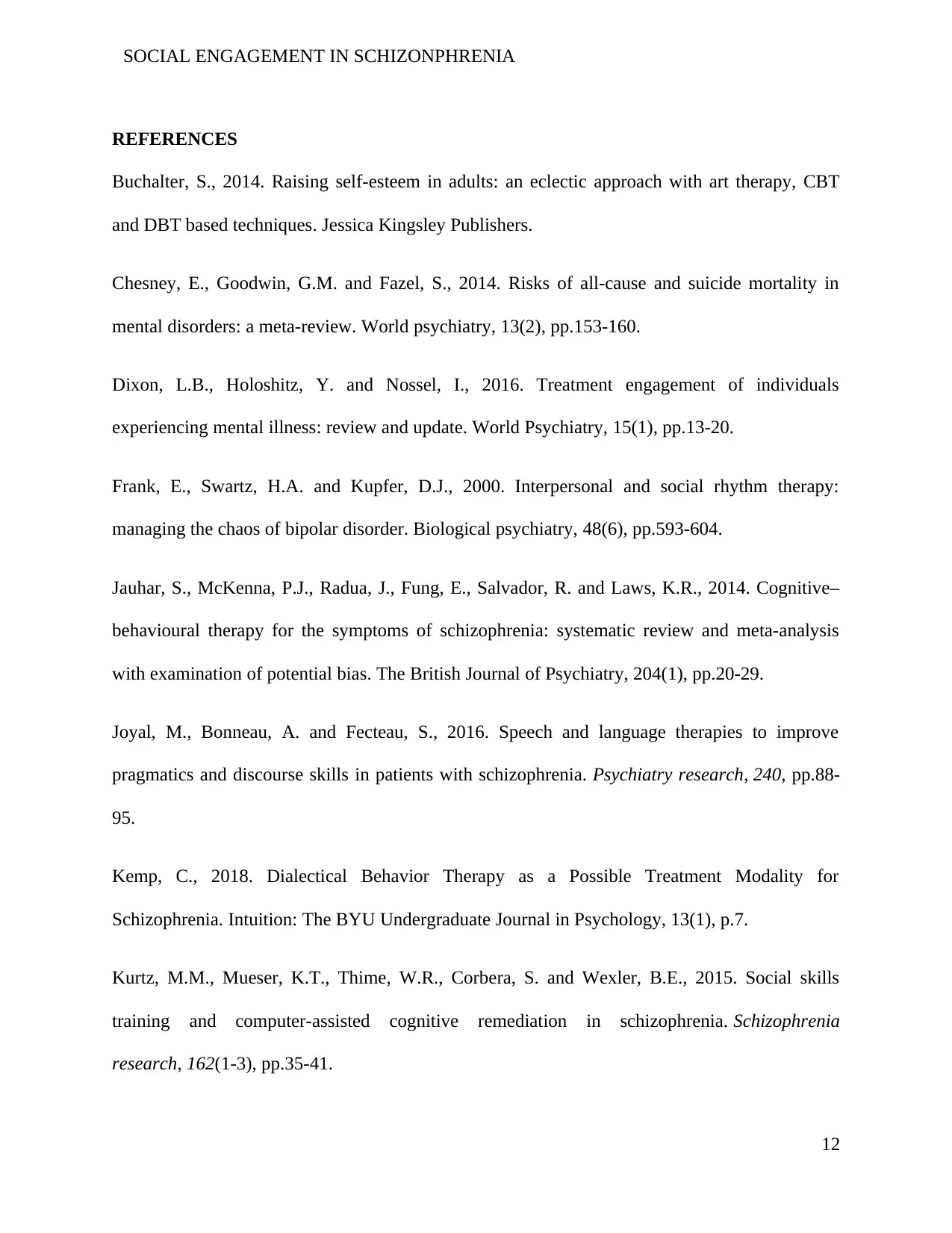
SOCIAL ENGAGEMENT IN SCHIZONPHRENIA
REFERENCES
Buchalter, S., 2014. Raising self-esteem in adults: an eclectic approach with art therapy, CBT
and DBT based techniques. Jessica Kingsley Publishers.
Chesney, E., Goodwin, G.M. and Fazel, S., 2014. Risks of all‐cause and suicide mortality in
mental disorders: a meta‐review. World psychiatry, 13(2), pp.153-160.
Dixon, L.B., Holoshitz, Y. and Nossel, I., 2016. Treatment engagement of individuals
experiencing mental illness: review and update. World Psychiatry, 15(1), pp.13-20.
Frank, E., Swartz, H.A. and Kupfer, D.J., 2000. Interpersonal and social rhythm therapy:
managing the chaos of bipolar disorder. Biological psychiatry, 48(6), pp.593-604.
Jauhar, S., McKenna, P.J., Radua, J., Fung, E., Salvador, R. and Laws, K.R., 2014. Cognitive–
behavioural therapy for the symptoms of schizophrenia: systematic review and meta-analysis
with examination of potential bias. The British Journal of Psychiatry, 204(1), pp.20-29.
Joyal, M., Bonneau, A. and Fecteau, S., 2016. Speech and language therapies to improve
pragmatics and discourse skills in patients with schizophrenia. Psychiatry research, 240, pp.88-
95.
Kemp, C., 2018. Dialectical Behavior Therapy as a Possible Treatment Modality for
Schizophrenia. Intuition: The BYU Undergraduate Journal in Psychology, 13(1), p.7.
Kurtz, M.M., Mueser, K.T., Thime, W.R., Corbera, S. and Wexler, B.E., 2015. Social skills
training and computer-assisted cognitive remediation in schizophrenia. Schizophrenia
research, 162(1-3), pp.35-41.
12
REFERENCES
Buchalter, S., 2014. Raising self-esteem in adults: an eclectic approach with art therapy, CBT
and DBT based techniques. Jessica Kingsley Publishers.
Chesney, E., Goodwin, G.M. and Fazel, S., 2014. Risks of all‐cause and suicide mortality in
mental disorders: a meta‐review. World psychiatry, 13(2), pp.153-160.
Dixon, L.B., Holoshitz, Y. and Nossel, I., 2016. Treatment engagement of individuals
experiencing mental illness: review and update. World Psychiatry, 15(1), pp.13-20.
Frank, E., Swartz, H.A. and Kupfer, D.J., 2000. Interpersonal and social rhythm therapy:
managing the chaos of bipolar disorder. Biological psychiatry, 48(6), pp.593-604.
Jauhar, S., McKenna, P.J., Radua, J., Fung, E., Salvador, R. and Laws, K.R., 2014. Cognitive–
behavioural therapy for the symptoms of schizophrenia: systematic review and meta-analysis
with examination of potential bias. The British Journal of Psychiatry, 204(1), pp.20-29.
Joyal, M., Bonneau, A. and Fecteau, S., 2016. Speech and language therapies to improve
pragmatics and discourse skills in patients with schizophrenia. Psychiatry research, 240, pp.88-
95.
Kemp, C., 2018. Dialectical Behavior Therapy as a Possible Treatment Modality for
Schizophrenia. Intuition: The BYU Undergraduate Journal in Psychology, 13(1), p.7.
Kurtz, M.M., Mueser, K.T., Thime, W.R., Corbera, S. and Wexler, B.E., 2015. Social skills
training and computer-assisted cognitive remediation in schizophrenia. Schizophrenia
research, 162(1-3), pp.35-41.
12
Paraphrase This Document
Need a fresh take? Get an instant paraphrase of this document with our AI Paraphraser
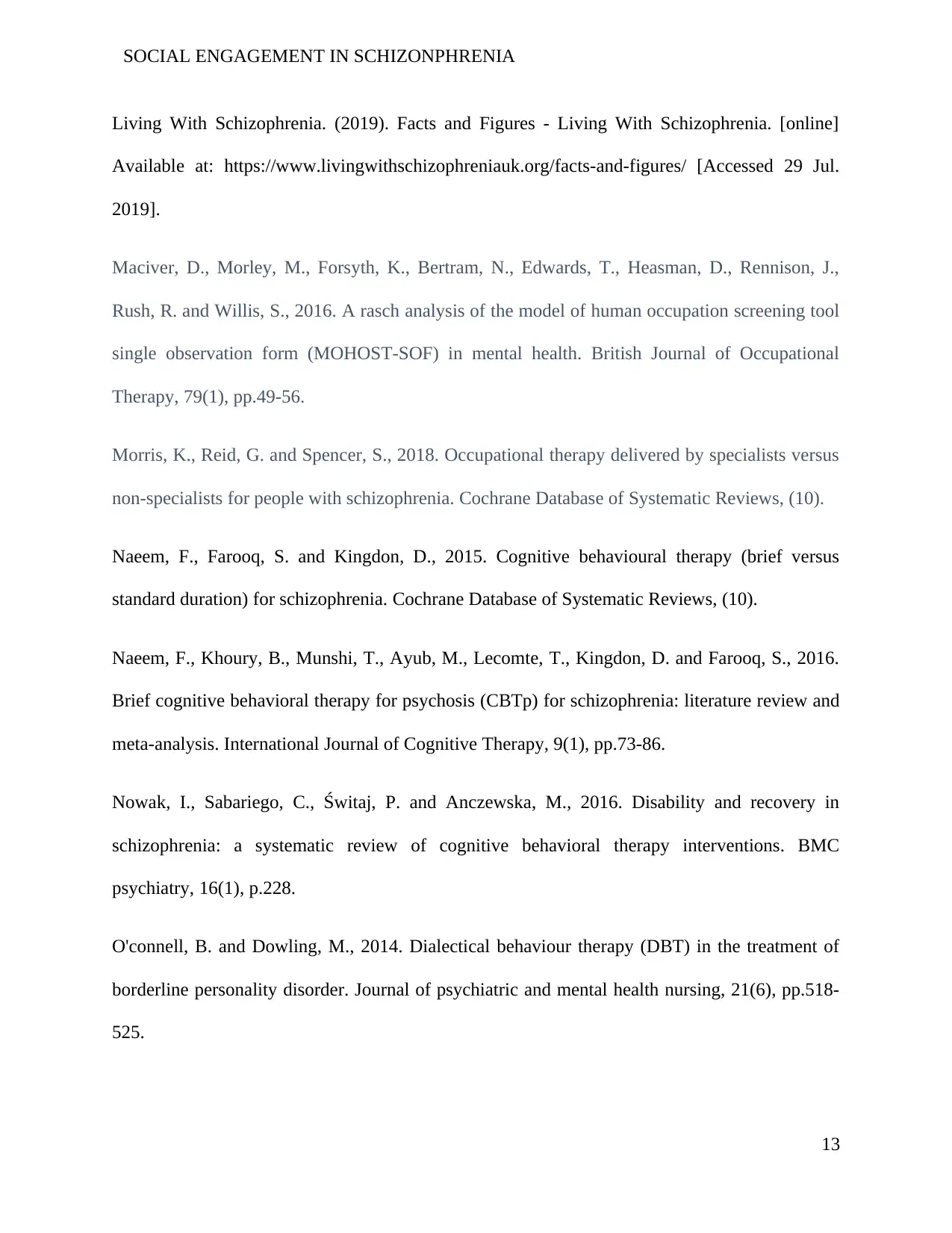
SOCIAL ENGAGEMENT IN SCHIZONPHRENIA
Living With Schizophrenia. (2019). Facts and Figures - Living With Schizophrenia. [online]
Available at: https://www.livingwithschizophreniauk.org/facts-and-figures/ [Accessed 29 Jul.
2019].
Maciver, D., Morley, M., Forsyth, K., Bertram, N., Edwards, T., Heasman, D., Rennison, J.,
Rush, R. and Willis, S., 2016. A rasch analysis of the model of human occupation screening tool
single observation form (MOHOST-SOF) in mental health. British Journal of Occupational
Therapy, 79(1), pp.49-56.
Morris, K., Reid, G. and Spencer, S., 2018. Occupational therapy delivered by specialists versus
non‐specialists for people with schizophrenia. Cochrane Database of Systematic Reviews, (10).
Naeem, F., Farooq, S. and Kingdon, D., 2015. Cognitive behavioural therapy (brief versus
standard duration) for schizophrenia. Cochrane Database of Systematic Reviews, (10).
Naeem, F., Khoury, B., Munshi, T., Ayub, M., Lecomte, T., Kingdon, D. and Farooq, S., 2016.
Brief cognitive behavioral therapy for psychosis (CBTp) for schizophrenia: literature review and
meta-analysis. International Journal of Cognitive Therapy, 9(1), pp.73-86.
Nowak, I., Sabariego, C., Świtaj, P. and Anczewska, M., 2016. Disability and recovery in
schizophrenia: a systematic review of cognitive behavioral therapy interventions. BMC
psychiatry, 16(1), p.228.
O'connell, B. and Dowling, M., 2014. Dialectical behaviour therapy (DBT) in the treatment of
borderline personality disorder. Journal of psychiatric and mental health nursing, 21(6), pp.518-
525.
13
Living With Schizophrenia. (2019). Facts and Figures - Living With Schizophrenia. [online]
Available at: https://www.livingwithschizophreniauk.org/facts-and-figures/ [Accessed 29 Jul.
2019].
Maciver, D., Morley, M., Forsyth, K., Bertram, N., Edwards, T., Heasman, D., Rennison, J.,
Rush, R. and Willis, S., 2016. A rasch analysis of the model of human occupation screening tool
single observation form (MOHOST-SOF) in mental health. British Journal of Occupational
Therapy, 79(1), pp.49-56.
Morris, K., Reid, G. and Spencer, S., 2018. Occupational therapy delivered by specialists versus
non‐specialists for people with schizophrenia. Cochrane Database of Systematic Reviews, (10).
Naeem, F., Farooq, S. and Kingdon, D., 2015. Cognitive behavioural therapy (brief versus
standard duration) for schizophrenia. Cochrane Database of Systematic Reviews, (10).
Naeem, F., Khoury, B., Munshi, T., Ayub, M., Lecomte, T., Kingdon, D. and Farooq, S., 2016.
Brief cognitive behavioral therapy for psychosis (CBTp) for schizophrenia: literature review and
meta-analysis. International Journal of Cognitive Therapy, 9(1), pp.73-86.
Nowak, I., Sabariego, C., Świtaj, P. and Anczewska, M., 2016. Disability and recovery in
schizophrenia: a systematic review of cognitive behavioral therapy interventions. BMC
psychiatry, 16(1), p.228.
O'connell, B. and Dowling, M., 2014. Dialectical behaviour therapy (DBT) in the treatment of
borderline personality disorder. Journal of psychiatric and mental health nursing, 21(6), pp.518-
525.
13
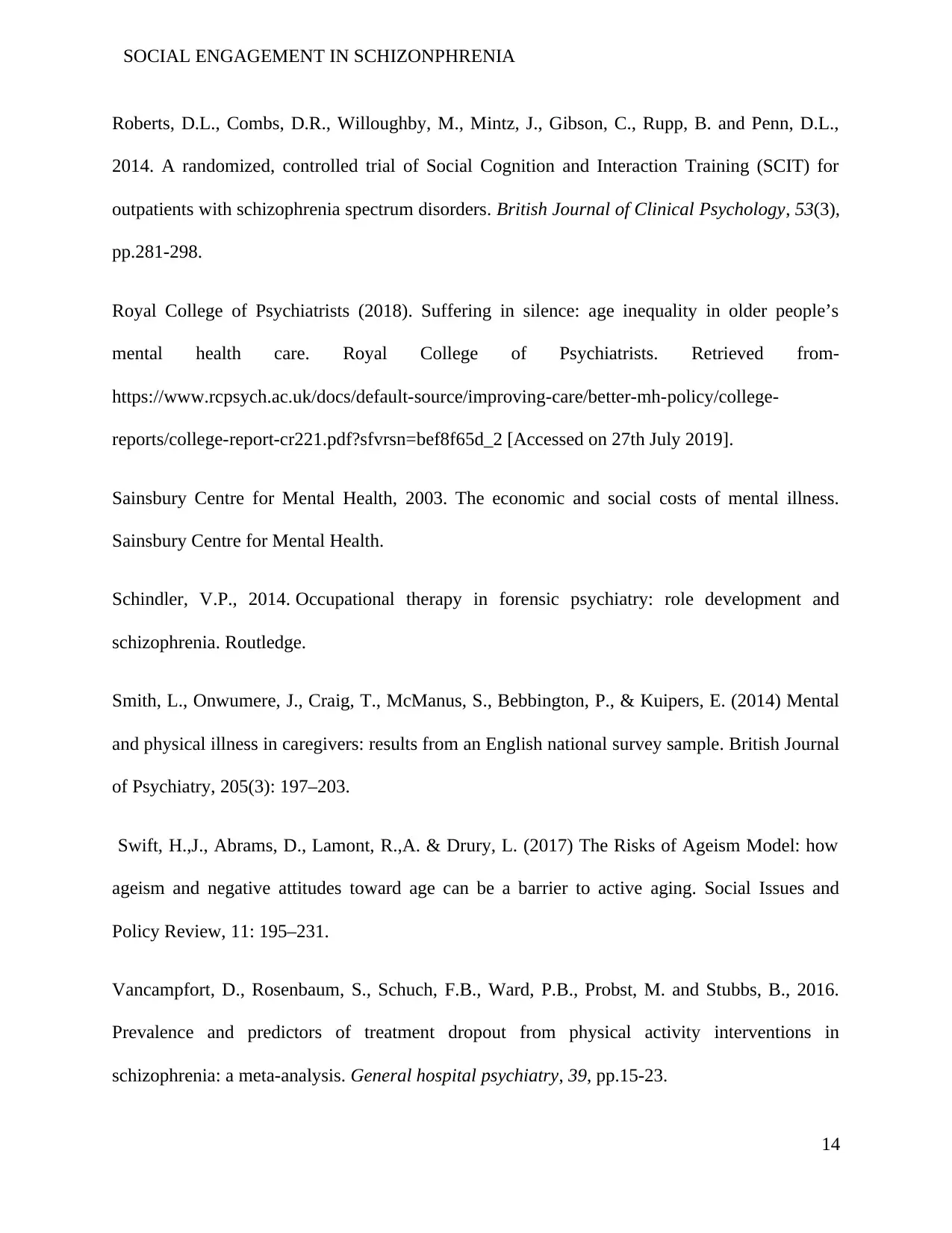
SOCIAL ENGAGEMENT IN SCHIZONPHRENIA
Roberts, D.L., Combs, D.R., Willoughby, M., Mintz, J., Gibson, C., Rupp, B. and Penn, D.L.,
2014. A randomized, controlled trial of Social Cognition and Interaction Training (SCIT) for
outpatients with schizophrenia spectrum disorders. British Journal of Clinical Psychology, 53(3),
pp.281-298.
Royal College of Psychiatrists (2018). Suffering in silence: age inequality in older people’s
mental health care. Royal College of Psychiatrists. Retrieved from-
https://www.rcpsych.ac.uk/docs/default-source/improving-care/better-mh-policy/college-
reports/college-report-cr221.pdf?sfvrsn=bef8f65d_2 [Accessed on 27th July 2019].
Sainsbury Centre for Mental Health, 2003. The economic and social costs of mental illness.
Sainsbury Centre for Mental Health.
Schindler, V.P., 2014. Occupational therapy in forensic psychiatry: role development and
schizophrenia. Routledge.
Smith, L., Onwumere, J., Craig, T., McManus, S., Bebbington, P., & Kuipers, E. (2014) Mental
and physical illness in caregivers: results from an English national survey sample. British Journal
of Psychiatry, 205(3): 197–203.
Swift, H.,J., Abrams, D., Lamont, R.,A. & Drury, L. (2017) The Risks of Ageism Model: how
ageism and negative attitudes toward age can be a barrier to active aging. Social Issues and
Policy Review, 11: 195–231.
Vancampfort, D., Rosenbaum, S., Schuch, F.B., Ward, P.B., Probst, M. and Stubbs, B., 2016.
Prevalence and predictors of treatment dropout from physical activity interventions in
schizophrenia: a meta-analysis. General hospital psychiatry, 39, pp.15-23.
14
Roberts, D.L., Combs, D.R., Willoughby, M., Mintz, J., Gibson, C., Rupp, B. and Penn, D.L.,
2014. A randomized, controlled trial of Social Cognition and Interaction Training (SCIT) for
outpatients with schizophrenia spectrum disorders. British Journal of Clinical Psychology, 53(3),
pp.281-298.
Royal College of Psychiatrists (2018). Suffering in silence: age inequality in older people’s
mental health care. Royal College of Psychiatrists. Retrieved from-
https://www.rcpsych.ac.uk/docs/default-source/improving-care/better-mh-policy/college-
reports/college-report-cr221.pdf?sfvrsn=bef8f65d_2 [Accessed on 27th July 2019].
Sainsbury Centre for Mental Health, 2003. The economic and social costs of mental illness.
Sainsbury Centre for Mental Health.
Schindler, V.P., 2014. Occupational therapy in forensic psychiatry: role development and
schizophrenia. Routledge.
Smith, L., Onwumere, J., Craig, T., McManus, S., Bebbington, P., & Kuipers, E. (2014) Mental
and physical illness in caregivers: results from an English national survey sample. British Journal
of Psychiatry, 205(3): 197–203.
Swift, H.,J., Abrams, D., Lamont, R.,A. & Drury, L. (2017) The Risks of Ageism Model: how
ageism and negative attitudes toward age can be a barrier to active aging. Social Issues and
Policy Review, 11: 195–231.
Vancampfort, D., Rosenbaum, S., Schuch, F.B., Ward, P.B., Probst, M. and Stubbs, B., 2016.
Prevalence and predictors of treatment dropout from physical activity interventions in
schizophrenia: a meta-analysis. General hospital psychiatry, 39, pp.15-23.
14
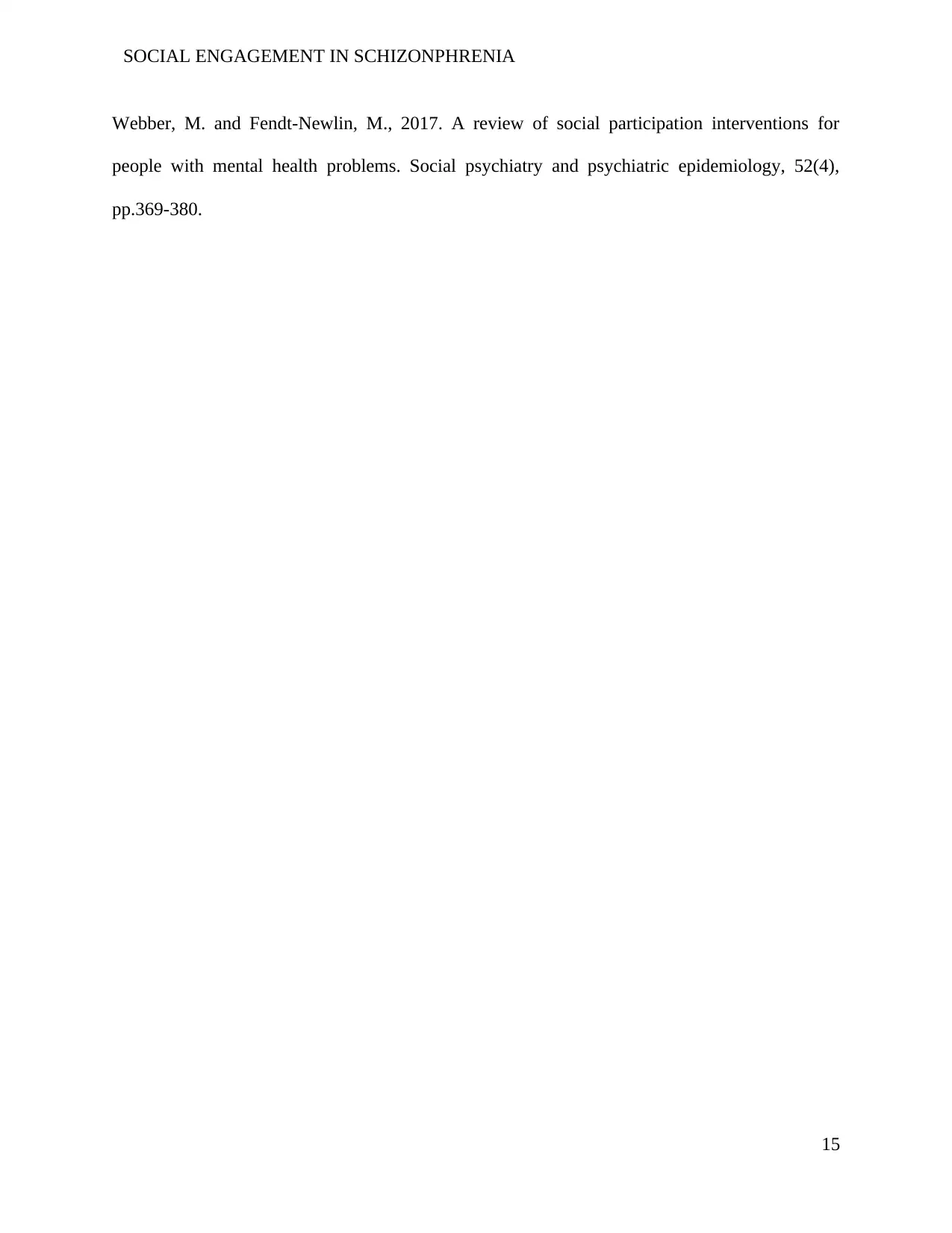
SOCIAL ENGAGEMENT IN SCHIZONPHRENIA
Webber, M. and Fendt-Newlin, M., 2017. A review of social participation interventions for
people with mental health problems. Social psychiatry and psychiatric epidemiology, 52(4),
pp.369-380.
15
Webber, M. and Fendt-Newlin, M., 2017. A review of social participation interventions for
people with mental health problems. Social psychiatry and psychiatric epidemiology, 52(4),
pp.369-380.
15
1 out of 16
Related Documents
Your All-in-One AI-Powered Toolkit for Academic Success.
+13062052269
info@desklib.com
Available 24*7 on WhatsApp / Email
![[object Object]](/_next/static/media/star-bottom.7253800d.svg)
Unlock your academic potential
© 2024 | Zucol Services PVT LTD | All rights reserved.





